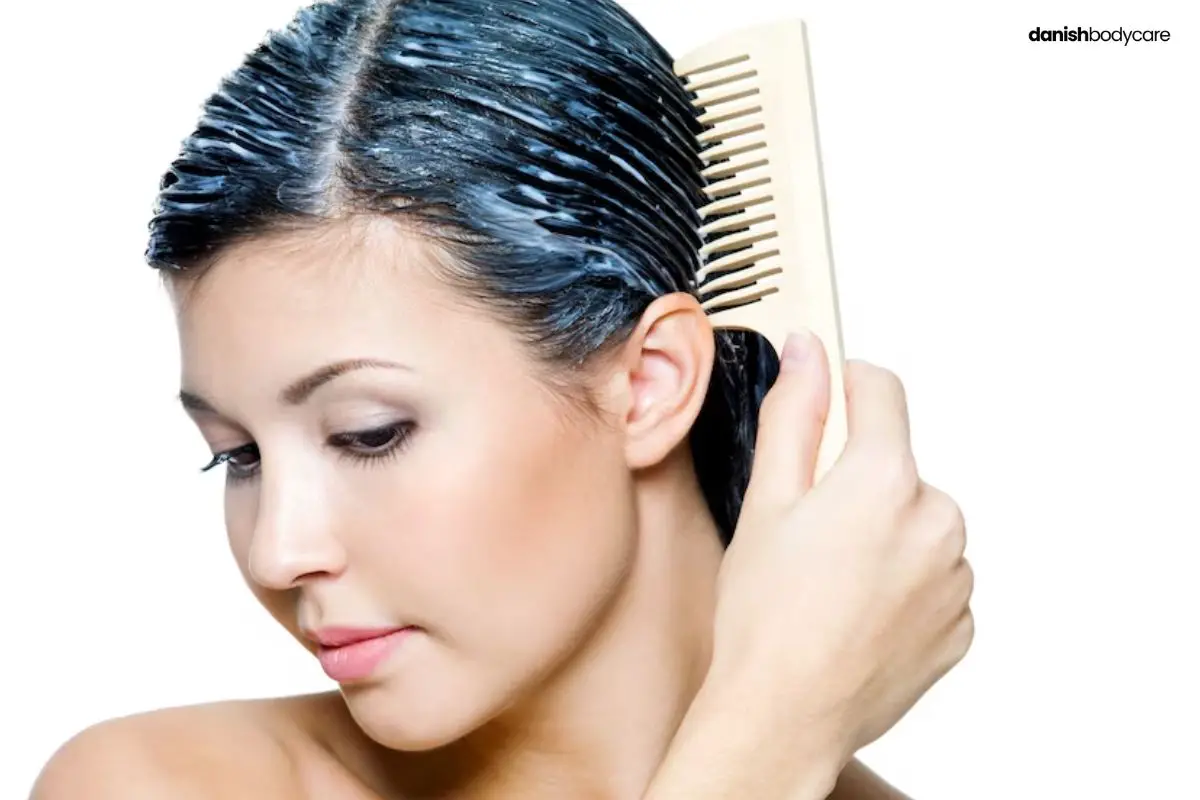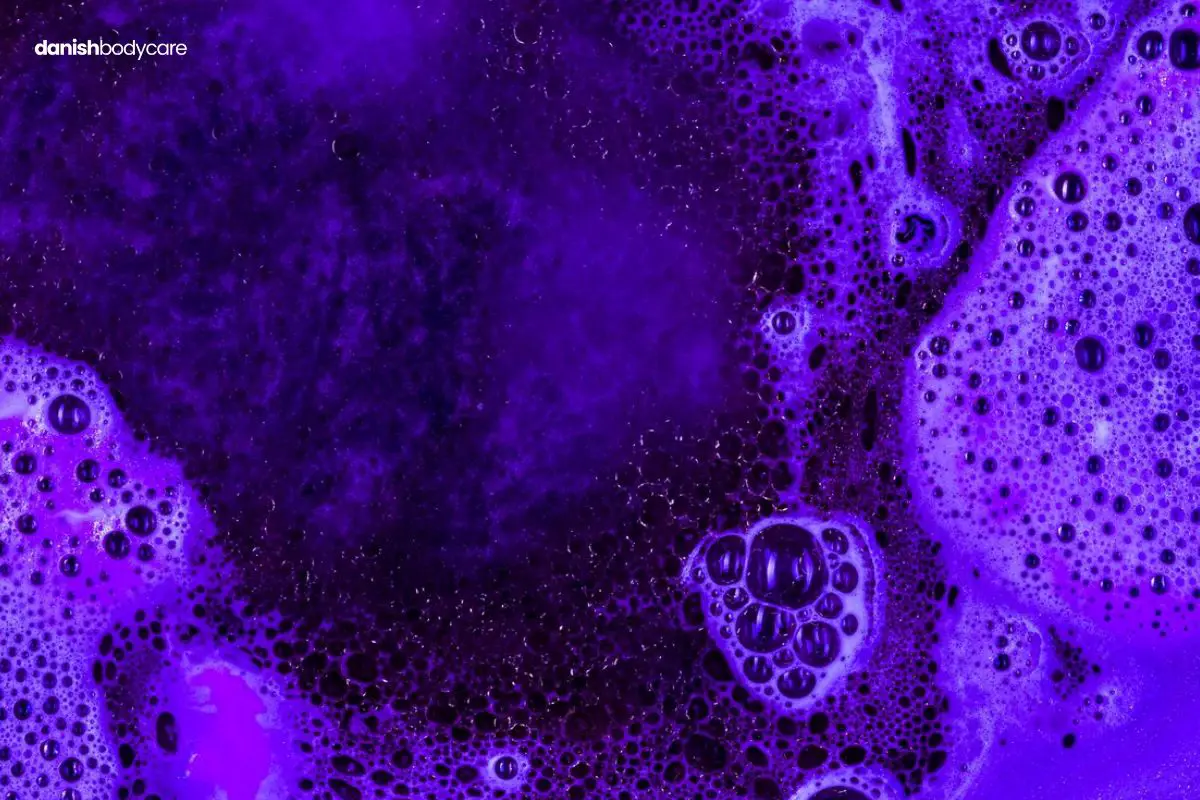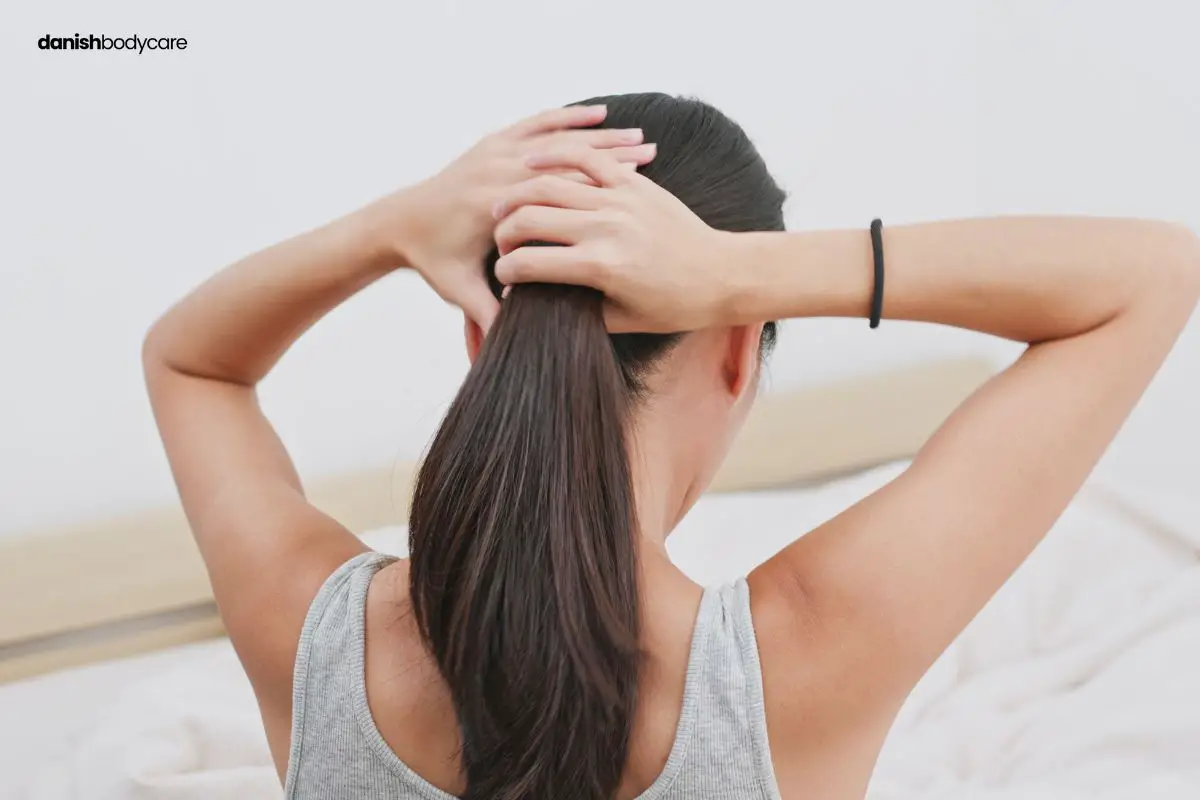Bleaching your hair is a popular way to achieve a dramatic change in your appearance. But, it’s not without its risks.
One of the most frustrating and embarrassing problems that can occur after bleaching your hair is that it turns blue.
This can happen to anyone, regardless of your hair type or color.
In this article, we explore the causes of blue hair after bleaching. We provide you with some tips on how to fix it and offer advice on how to prevent it from happening in the first place.
Common Hair Color Issues After Bleaching
Bleaching is not always easy. A lot of at-home bleachers have color issues, especially if it’s your first time:
- Brassy or orange hair
- Yellow tones
- Greenish tints
- Too light or over-bleached hair
- Uneven hair color or patchiness
- Red or coppery hair
- Blue or violet tones
- Greyish or ashy hair
Brassy or Orange Hair
It’s common for your hair to look brassy or orange after bleaching. This is because the bleach may not have removed all the warm pigments from your hair.
Yellow Tones
Yellow tones may appear if the bleach didn’t completely lift the warm pigments. You can use purple shampoo to neutralize it.
Greenish Tints
Swimming in chlorinated water can cause greenish tints after bleaching. Using hair products with blue or green pigments can also do that. To fix it, use a clarifying shampoo.
Too Light or Over-Bleached Hair
If your hair is too light or over-bleached, use a gentle demi-permanent dye. This will help you achieve the desired shade.
Uneven Hair Color or Patchiness
Uneven color or patchiness can occur if the bleach isn’t applied evenly. Apply a hair color with a similar level and tone to even it out.
Red or Coppery Hair
Red or coppery hair may result from not bleaching enough to remove red pigments. Applying an ash-based toner should neutralize the unwanted color.
Blue or Violet Tones
Your hair may turn blue or violet if over-toning occurs. Use a clarifying shampoo to remove the excess color.
Greyish or Ashy Hair
If your hair looks greyish or ashy, it could be a result of using too much toner or an ash-based dye. To correct it, try a warm-toned color or consult a professional hair colorist.
Why Your Hair Turns Blue After Bleaching
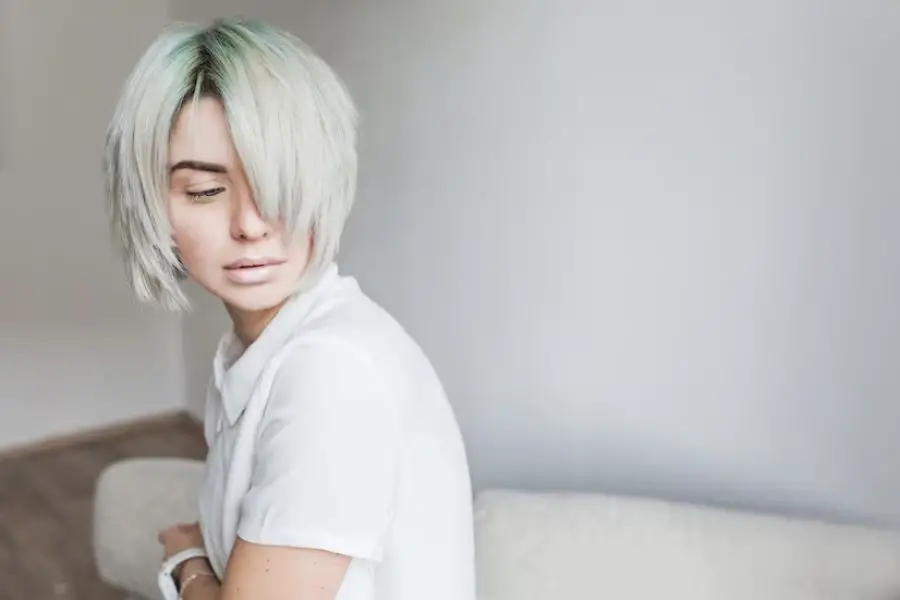
Your hair can turn blue after bleaching for various reasons.
The previous color and pigmentation of your hair play a role. If your hair had a cool tone before bleaching, the blue shades might show up after you use the bleach.
An incorrect bleaching technique can lead to the appearance of blue hair. Leaving the bleach on for too long, using the wrong mixing ratios, or applying it incorrectly can result in the unwanted blue hue.
Exposure to swimming pool chemicals can also contribute to blue hair after bleaching. Chlorine in pools can react with the bleach in your hair, causing it to take on a blue tone.
Using hard water to wash your hair may lead to mineral buildup. This reacts with the bleached color and creates a blue tint.
Read on to find out about:
- How hair pigments work
- The effect of bleaching on hair color
How Hair Pigments Work
Your hair’s natural color comes from a pigment called melanin.
There are two types of melanin: eumelanin and pheomelanin. Eumelanin creates brown and black colors, while Pheomelanin makes yellow and red colors.
The combination and amount of these pigments determine your specific hair color.
The Effect of Bleaching on Hair Color
Bleaching works by breaking down the melanin in your hair to strip the color away, allowing you to dye it a new shade.
However, the removal of melanin is not always even. This can cause certain undesired color changes, such as turning the hair blue.
When bleaching black hair without damage, the process can remove more pheomelanin than eumelanin. The result is an uneven blue or green tint.
Elements like dryness or damage to hair can also contribute to this effect.
After bleaching your hair, take good care of it by providing proper nourishment. This prevents unexpected color changes and reduces the risk of damaging your hair.
Common Causes of Blue Tones in Bleached Hair
The appearance of blue tones in bleached hair can result from several factors.
Here are the main reasons for the presence of blue tones after bleaching:
- Previous hair color and pigmentation
- Incorrect bleaching technique
- Swimming pool chemicals
- Hard water
Previous Hair Color and Pigmentation
Your hair might turn blue after bleaching due to the previous hair color or pigmentation still in your hair.
If your hair had a cool tone before, the blue shades might become more visible when you bleach it. To avoid this, use a color remover before bleaching to strip away the previous color.
Incorrect Bleaching Technique
Using the wrong bleaching technique can result in blue tones.
If you leave the bleach on for too long or mix it incorrectly, it strips too much color from your hair. This causes the blue hue to appear.
Follow the instructions on the bleaching product. Also, do a strand test before applying it to your whole head.
Swimming Pool Chemicals
Swimming in a pool with high levels of chlorine can cause your bleached hair to turn blue.
The chemicals in the water react with the bleach and cause the unwanted blue tone.
To prevent this, wear a swim cap or rinse your hair with clean water before and after swimming. This minimizes exposure.
Hard Water
Hard water contains high mineral content. This mineral content can sometimes cause blue tones in bleached hair.
The minerals in hard water build up in your hair and react with the bleached color.
To combat this issue, use a water softener or a clarifying shampoo. These products remove mineral buildup from your hair.
Other Causes
Here’s a table that includes some more possible causes for blue tones in bleached hair:
| Cause | Explanation | Prevention |
|---|---|---|
| Hair Products | Some hair care products contain pigments that cause blue tones, especially if they’re for color-treated hair. | Use products without dyes or color enhancers. |
| Exposure to Sunlight | Sun’s UV rays can change hair color, leading to a blue tone, especially for bleached hair. | Limit hair’s exposure to sunlight, use hats, or use UV-protection sprays for hair. |
| Health Condition | Certain health conditions or medications can affect how hair reacts to bleach. | Consult a medical professional. They can explain how your health condition or medications might affect hair color. |
| Diet | Diet can sometimes affect hair color, especially if you lack certain nutrients. | Maintain a balanced diet rich in vitamins and minerals. |
| Quality of Hair Dye | Lower quality hair dyes may have impurities causing unexpected color results. | Choose high-quality, reputable hair dye brands. |
| Hair’s Porosity | Hair with high porosity can absorb color more deeply, leading to intense results. | Conduct a hair porosity test and adjust your bleaching method. |
How to Get Rid of Blue Tint in Bleached Hair
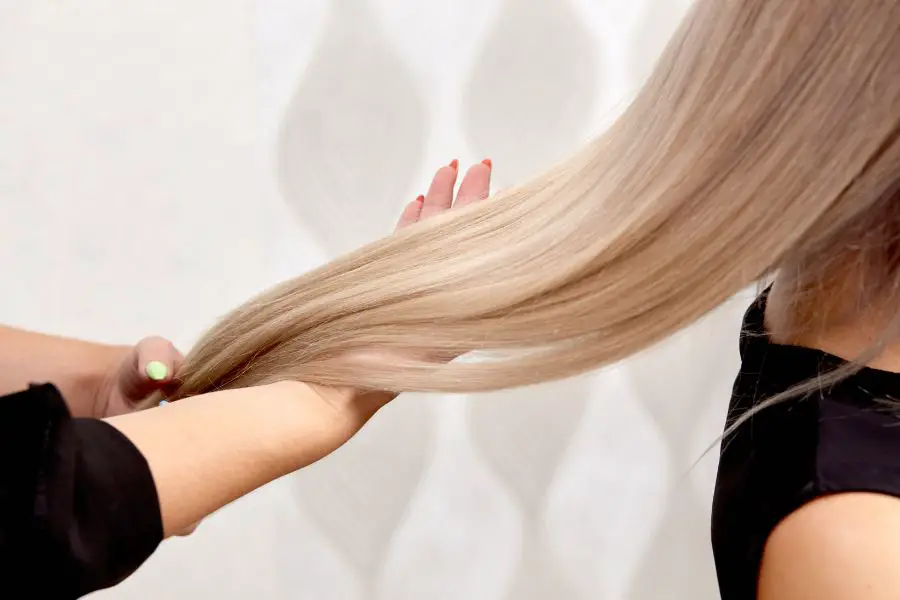
If you’re facing the challenge of a blue tint in your bleached hair, don’t worry. There are effective solutions to restore your desired hair color.
Explore the following list of remedies and methods to get rid of the unwanted blue hue:
- Color remover
- Anti-dandruff shampoo
- Clarifying shampoo
- Dish soap
- Sun exposure
- Bath salts
- Swimming
- Bleach
- Opposing hair dye
- Moisturizing mask
- Lemon juice
- Vitamin C
- Professional help
Color Remover
Use a color remover to eliminate the blue tint in your hair.
Choose a reliable brand and follow the instructions on the package. Condition your hair afterward to keep it healthy and hydrated.
Anti-Dandruff Shampoo
Anti-dandruff shampoo works wonders in eliminating color from hair.
Choose the right type, such as blue or silver shampoo, and lather it well. Rinse your hair with warm water and follow up with a conditioner.
Clarifying Shampoo
Clarifying shampoo can also assist in fading the blue tint from your hair.
This shampoo type removes build-up and excess color. Wash your hair using this product and let it sit for a few minutes before rinsing.
Dish Soap
Dish soap has a reputation for breaking down hair dye.
Massage a small amount of dish soap into your hair, leaving it for a short time. Rinse your hair and follow up with a moisturizing conditioner.
Sun Exposure
Spending time in the sun can lighten your hair color in a natural way.
The friendly sunlight fades the blue tint. It also gives your hair a more natural appearance in the process.
Bath Salts
Add bath salts to warm water and soak your hair for about 20 minutes.
This method works well with softening the blue color. Bath salts open up the hair cuticles and remove the dye.
Swimming
Swimming in chlorinated water can aid in removing the blue tint.
The chlorine helps to strip away color. Be cautious not to overdo it though, as continuous contact with chlorine harms your hair.
Bleach
Using bleach is a fast way to remove the blue tint, but it can be harsh on your hair.
If you decide to use this method, follow the instructions precisely. Apply a moisturizing mask afterward.
Opposing Hair Dye
By using a hair dye with an opposing color, like orange or red, you can neutralize the blue tint.
Select a shade that suits your hair and follow the instructions.
Lemon Juice
Mix lemon juice with water and apply it to your hair.
The natural acidity fades the blue tint. Rinse it out after 10 to 15 minutes and follow it up with a conditioner.
Vitamin C
Crush a few vitamin C tablets and mix them with water, creating a paste.
Apply this paste to your hair, and let it sit for about 30 minutes before washing it out.
Moisturizing Mask
Apply a moisturizing mask after removing the blue tint to keep your hair healthy and hydrated.
Some color removal processes can be drying to your hair. So, it is important to replenish moisture with a good mask.
Professional Help
If all else fails, or if you prefer not to experiment with DIY methods, seeking professional help from a hairstylist is your best option.
They can look at your hair and suggest the right way to remove the blue tint.
How Long Does It Take to Get Rid of Blue Color in Bleached Hair?
Generally, a semi-permanent dye fades in 10-15 washes.
Getting rid of the blue color in your bleached hair depends on the dye type and your hair care routine.
Use a clarifying shampoo and gentle conditioning treatments. Patience is key!
How to Prevent Blue Hair After Bleaching
Preventing blue hair after bleaching is possible with some simple yet essential steps.
Take a look at the following list of measures to avoid the appearance of blue tones in your bleached hair:
- Strand testing before full bleaching
- Use high-quality bleaching products
- Regularly deep condition and moisturize hair
Strand Testing Before Full Bleaching
Before bleaching your entire head, perform a strand test.
This way, you can determine how your hair reacts to the bleach. Choose a small, hidden section of hair, apply bleach, and check the result.
If it turns blue, tweak the bleach mixture or try a different product.
Use High-Quality Bleaching Products
Invest in high-quality bleaching products.
They contain proper formulations to help reduce the chances of unwanted color results. Look for products with good reviews and professional recommendations.
Using better products will protect your hair from damage. It will also ensure a safer bleaching process.
Regularly Deep Condition and Moisturize Hair
Bleached hair is prone to dryness and damage, which can impact the color outcome. By deep conditioning and moisturizing your hair, you improve its health.
You also make it less likely to have unwanted blue tones. Use hair masks, natural oils (like olive or coconut), and gentle shampoos and conditioners for color-treated hair.
Maintain a healthy hair care routine to ensure the best results post-bleaching.
How to Get Rid of Blue Tint in Hair from Purple Shampoo

Has purple shampoo left a blue tint in your hair after bleaching? No worries! You can try using a clarifying shampoo to remove excess color. Consider a gentle hair mask after rinsing.
Another option is crushing vitamin C tablets and mixing them with a dye-free clarifying shampoo. Then apply them to your hair.
Frequently Asked Questions
What to do if hair turns blue after bleaching?
If your hair turns blue after bleaching, try using a clarifying shampoo to remove the blue tint. Massage the shampoo into your hair and rinse. You can also use a hair color remover to get rid of the blue color. If these options don’t work, it’s best to consult a professional hair stylist. They will provide further help.
Why is my hair turning blue-green after bleaching?
Your hair might be turning blue-green after bleaching because of mineral deposits or chlorine in the water. This can react with the bleach and create a blue-green tint. To prevent this, use a chelating shampoo. It removes mineral build-up. You can also use a conditioner designed for color-treated hair.
How do you get blue toner out of blonde hair?
To get blue toner out of blonde hair, use a clarifying shampoo or a hair color remover. Apply the product as instructed and rinse well with lukewarm water. Repeat this process a few times to see visible results. Follow up with a deep conditioner to restore moisture to your hair.
How do you get blue-green out of blonde hair?
You can get blue-green out of blonde hair by using a color-correcting shampoo or hair mask with red or purple pigments. These products neutralize the unwanted blue-green tones in your hair. Use them as per the instructions and be patient. It might take a few washes to see a noticeable difference.
Why did blue shampoo turn my hair blue?
Blue shampoo can turn your hair blue if it’s used too often or left on your hair for too long. It’s designed to neutralize orange or brassy tones in lightened hair. It can deposit blue pigments if overused. To avoid this issue, follow the instructions and don’t use blue shampoo more than once or twice a week.




